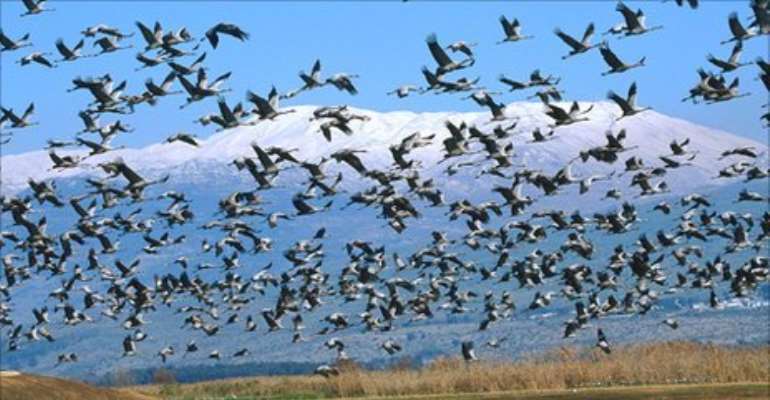BIRD WATCHERS FIND HEAVEN IN ‘SUPERHIGHWAY’ ISRAEL

Per square kilometre, the country has one of the highest levels of bird traffic in the world
Tucked into the tiny open-top cockpit of a two-seater glider has to be one of the best ways to see Israel and the occupied Palestinian Territories.
Air rushes around the ears as the glider rises on the thermals. All around, hundreds of pelicans are soaring effortlessly, their wings glistening in the bright sunshine.
They seem almost close enough to reach out and touch.
“These are non-flapping birds,” says my pilot, Nani Roserstein. “Non-flapping, all the way to Africa.”
Bird migration is big in Israel. Per square kilometre, the country has one of the highest levels of bird traffic in the world.
Israel sits on the junction of three continents. Politically, it's a disaster, but for bird migration, it's heaven'
Dr Yossi Leshem
Director of Israel's International Centre for the Study of Bird Migration
Every autumn, over 500 million birds cross Israel's airspace, heading south to warming weather in Africa.
“Israel sits on the junction of three continents,” says Dr Yossi Leshem, director of Israel's International Centre for the Study of Bird Migration.
“Politically, it's a disaster, but for bird migration, it's heaven. We have a huge bird bottleneck, a superhighway.”
Dr Leshem explains that most birds prefer to fly over land when migrating. It allows them to save energy by flying using warm thermal air rising off the land below.
Many birds flying south from Northern Europe and Asia to Africa want to avoid the Mediterranean and Caspian seas and are therefore funnelled down over Israel and the Palestinian territories.
Hundreds of different species cross the region every autumn. In the spring, they head back the other way.
Dr Leshem says Israel is on the second busiest bird migration route in the world, trailing behind only Panama in Central America.
“These are cranes, we've got as many as 42,000 of them here,” he says – over a cacophony of squawking – as he guides me around the Hula Valley is northern Israel.
“They've flown down from Northern Russia. Many will stay here over the winter, feeding on the peanut fields. Some fly on to Africa.”
Collision hazard
But a billion birds crossing such a small air space every year causes major problems for pilots, especially in Israel's substantial air force.
“As the bird entered my right jet engine, a huge flame shot out the back. I had only seconds to hit the ejector seat button,” says Israel Baharav, one of the country's most decorated fighter pilots.
Birds can be a major problem for pilots
Baharav is 65 now. He has fought in several major wars, including the 1967 Six-Day War and the Yom Kippur conflict in 1973.
But the closest he came to death and one of the only times he had to use the ejector seat was when he hit a buzzard when travelling at over 700km/h (435mph).
“The bird weighed around 6kg (13lb),” Mr Baharav says.
“But at that kind of speed, the impact is the equivalent of around 40 tonnes. That's 40,000kg of impact.”
Mr Baharav smiles as he speaks, but his fighter jet crashed. He knows he is lucky to be alive.
Saving lives
His accident, as well as others, led the Israeli Air Force to seek the help of Dr Leshem to set up a special bird-monitoring unit.
The air force installed state-of-the-art radar technology capable of picking up bird flocks.
It also worked with Dr Leshem to set up a network of bird watchers across Israel and a telephone hotline to report migrating flocks.
“It's been hugely successful,” says Dr Leshem. “The number of collisions between birds and planes dropped dramatically.”
Dr Leshem says after the unit was set up, there was a 76% reduction in bird strikes over Israel. He estimates this has saved the air force up to $800m (£516m) in damage.
But he says this is not the most significant benefit.
“The most important thing is the pilot and the birds,” says Dr Leshem.
“I am sure we have saved several lives of pilots as well as tens of thousands of birds.”
